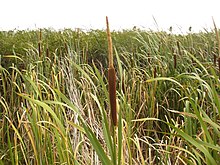Cattail plants
| Cattail plants | ||||||||||||
|---|---|---|---|---|---|---|---|---|---|---|---|---|

Hedgehog cob ( Sparganium erectum ) |
||||||||||||
| Systematics | ||||||||||||
|
||||||||||||
| Scientific name | ||||||||||||
| Typhaceae | ||||||||||||
| Yuss. |
The bulrush family (Typhaceae) are a plant family in the order of the sweet grass-like (Poales). These marsh or aquatic plants are found practically all over the world.
description

Vegetative characteristics
The species of the bulrush family thrive as swamp or aquatic plants. They grow as perennial herbaceous plants and form creeping rhizomes as persistent organs. The sturdy to slender stems are simple or branched. The alternate and two lines arranged on the stem leaves are upright and are located above or below water. There is a leaf sheath. The leaf blade is simple and has entire margins.
Generative characteristics
The species are single sexed ( monoecious ). The bracts are similar to foliage. The inflorescences are built up very differently in the two genera. In the cattail species there is a simple "piston" on the stem; this is a cylindrical, spiked inflorescence with female flowers at the bottom and male flowers at the top. In the hedgehog cob , there are some purely male or purely female spherical partial inflorescences in a branched, panicle , racemose or spike-like overall inflorescence, with the male being arranged above the female.
The many, very small flowers are unisexual and usually threefold. The inflorescence is absent or reduced and then consists of three or six elongated, scale-shaped bracts. The male flowers contain (one to) three or six (to eight) stamens . The dust bags open with a longitudinal slit. Nectaries are missing. The female flowers stand over a cover leaf or fine hair. The ovary is pseudomonomer or rarely zweikammerig and includes a hanging, apotrope ovule per carpel . The simple or bifurcated stylus ends in a long or two, unilateral, widened or spatula-shaped scar .
The tiny nut-like closing fruits , if there is a fruit stalk, fall off with it. The seed coat (testa) is thin.
The basic chromosome number is x = 15.
Systematics and distribution
The family of the cattail plants (Typhaceae) belongs to the order of the sweet grass-like (Poales). The Typhaceae occur in tropical to temperate areas of the world. The family contains only two genera with about (25 to) 35 species:
- Hedgehog's cob ( Sparganium L.): with about 19 species mainly in temperate to cool areas of the world. Most species are native to the northern hemisphere. There are about eleven species in China, three of which are only found there.
- Cattail ( Typha L.): with about 16 species in tropical to temperate areas of the world. There are about twelve species in China, three of which are only found there.
The genus Sparganium used to be the only family of the Sparganiaceae Hanin and the genus Typha alone was the family Typhaceae Juss. s. st. Molecular genetic studies show that the two genera are closely related and belong to one family, the Typhaceae family. l. This family is about 109 million years old and the two genera separated about 89 million years ago. There is a lot of fossil evidence from the Cretaceous period. (For the systematic position of Sparganium, see also Igelkolbengewächse # Systematics and distribution .)
swell
- The family of Typhaceae in APWebsite (section classification and description).
- Kun Sun, David A. Simpson: Typhaceae. In: Wu Zheng-yi, Peter H. Raven, Deyuan Hong (Eds.): Flora of China . Volume 23: Acoraceae through Cyperaceae . Science Press / Missouri Botanical Garden Press, Beijing / St. Louis 2010, ISBN 978-1-930723-99-3 , pp. 158-162 (English). , PDF file (sections Description, Distribution and Systematics).
Individual evidence
- ↑ a b c d e f g h i j k l m n Kun Sun, David A. Simpson: Typhaceae. In: Wu Zheng-yi, Peter H. Raven, Deyuan Hong (Eds.): Flora of China . Volume 23: Acoraceae through Cyperaceae . Science Press / Missouri Botanical Garden Press, Beijing / St. Louis 2010, ISBN 978-1-930723-99-3 , pp. 158-162 (English). , PDF file .
- ^ A b Manfred A. Fischer, Karl Oswald, Wolfgang Adler: Excursion flora for Austria, Liechtenstein and South Tyrol . 3rd, improved edition. State of Upper Austria, Biology Center of the Upper Austrian State Museums, Linz 2008, ISBN 978-3-85474-187-9 .
- ↑ a b c d e The family Typhaceae in APWebsite of PF Stevens. , last accessed November 18, 2011.
- ↑ Angiosperm Phylogeny Group : An update of the Angiosperm Phylogeny Group classification for the orders and families of flowering plants: APG III. In: Botanical Journal of the Linnean Society. Volume 161, No. 2, 2009, pp. 105-121, DOI: 10.1111 / j.1095-8339.2009.00996.x .
